Solutions SE 1 Anish (PDF)
File information
This PDF 1.5 document has been generated by convertonlinefree.com, and has been sent on pdf-archive.com on 16/02/2016 at 19:06, from IP address 1.186.x.x.
The current document download page has been viewed 556 times.
File size: 596.84 KB (5 pages).
Privacy: public file
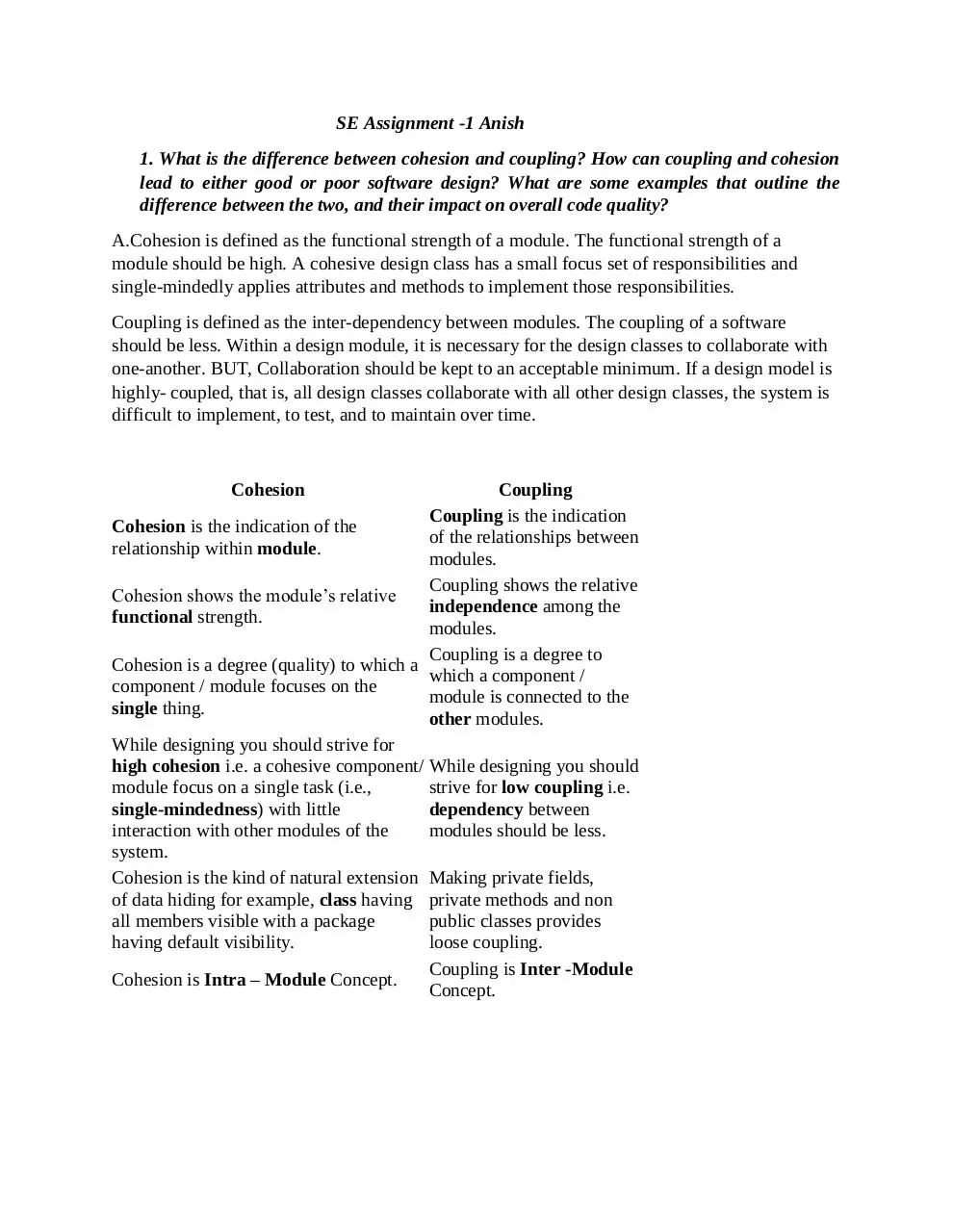
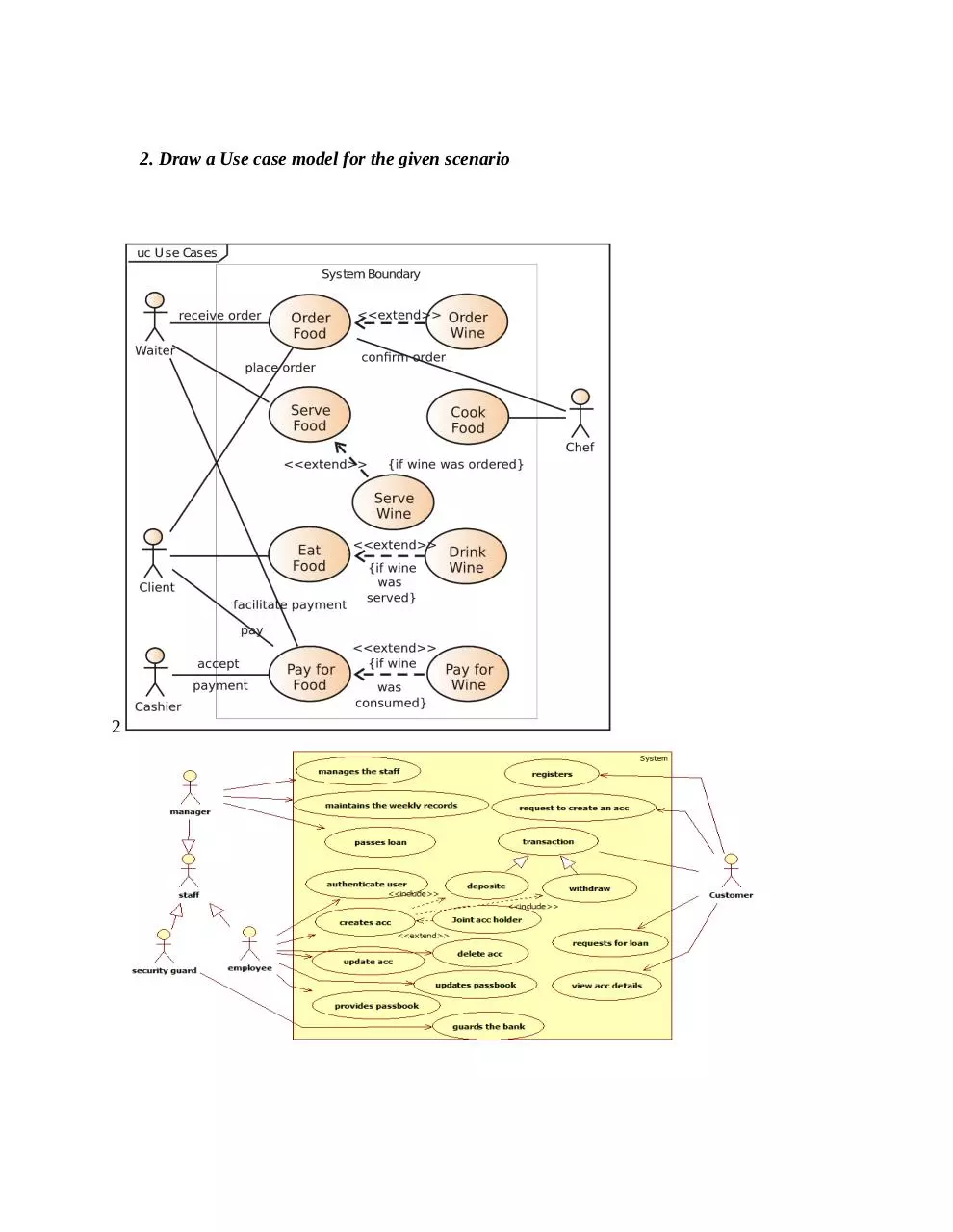
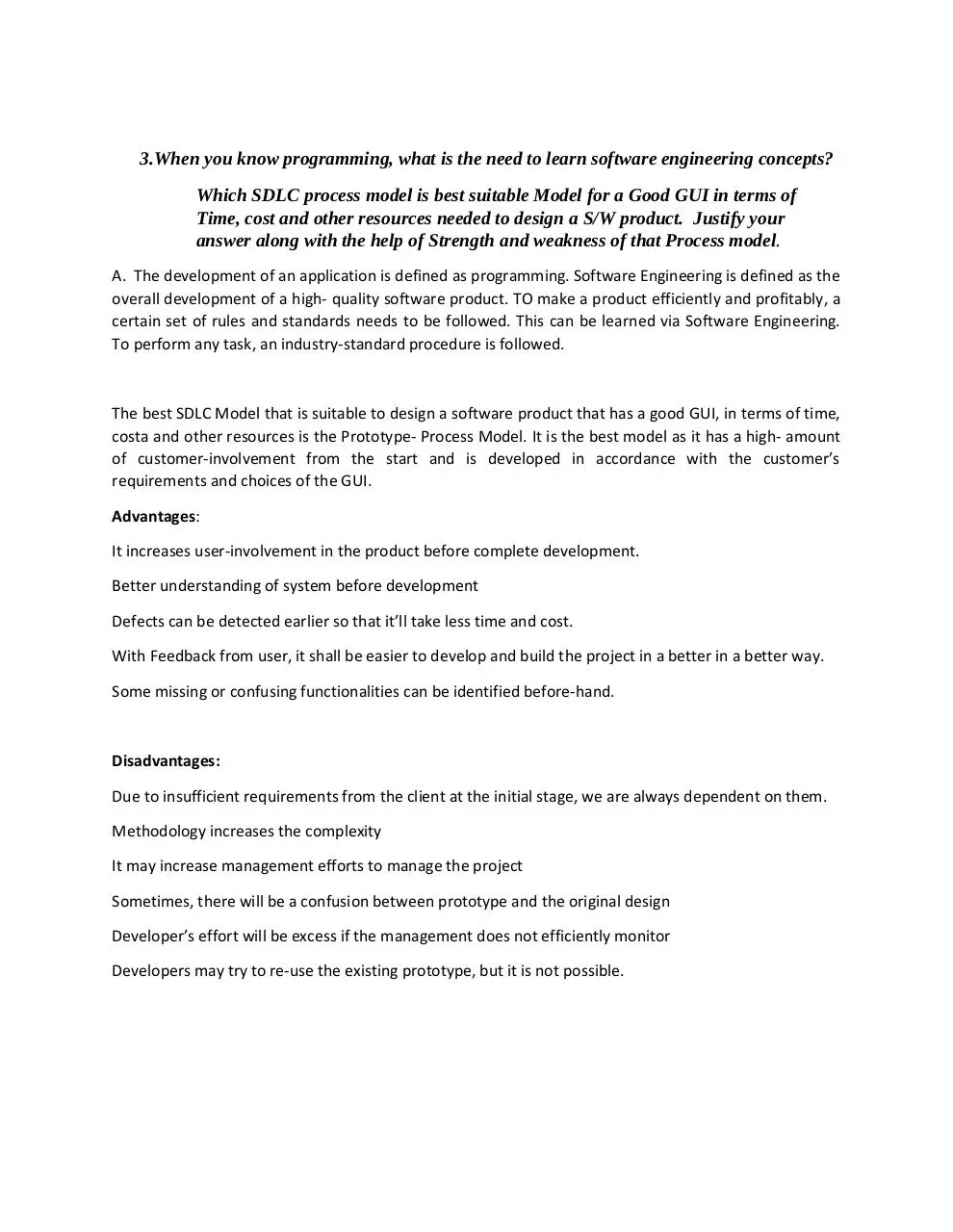
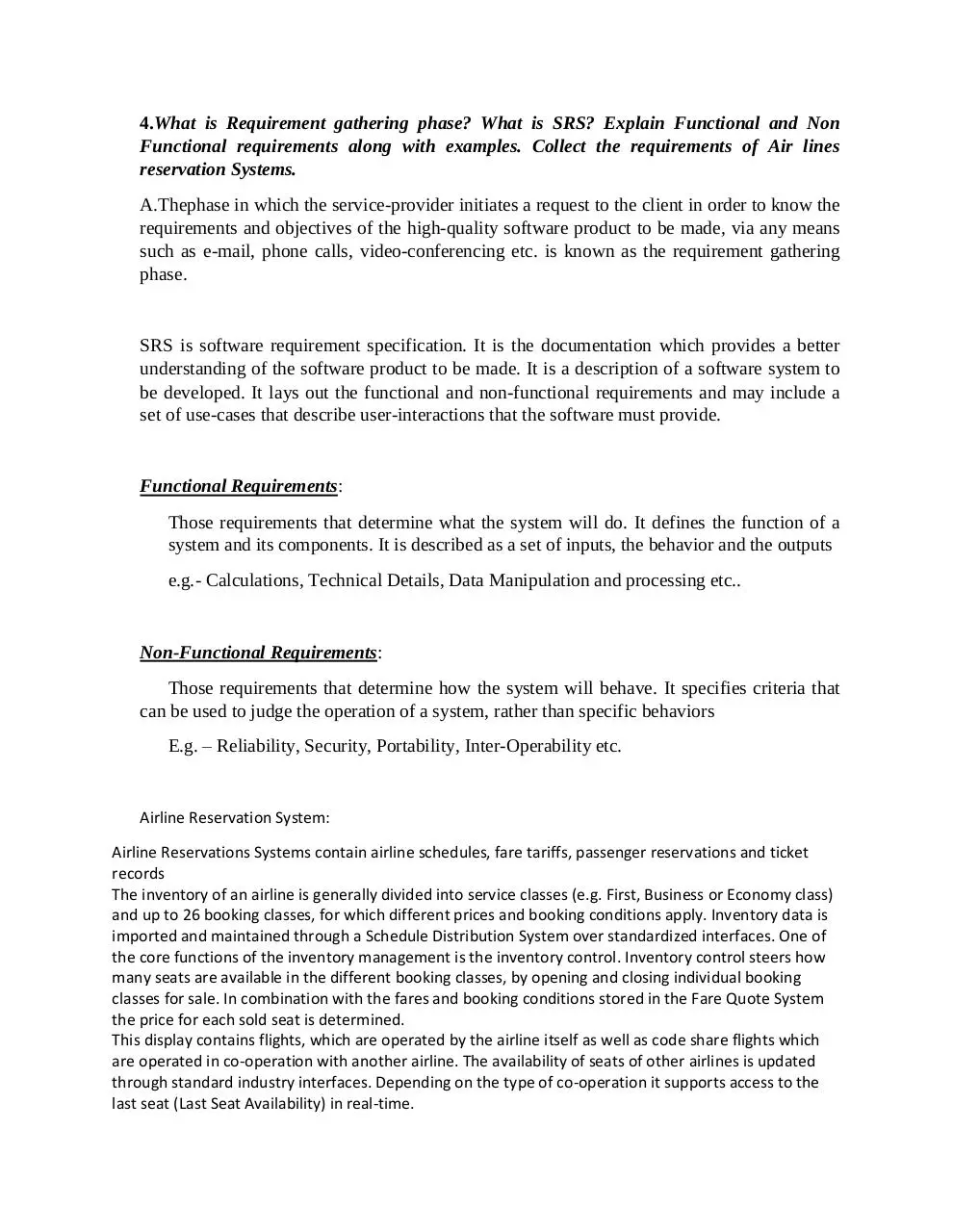
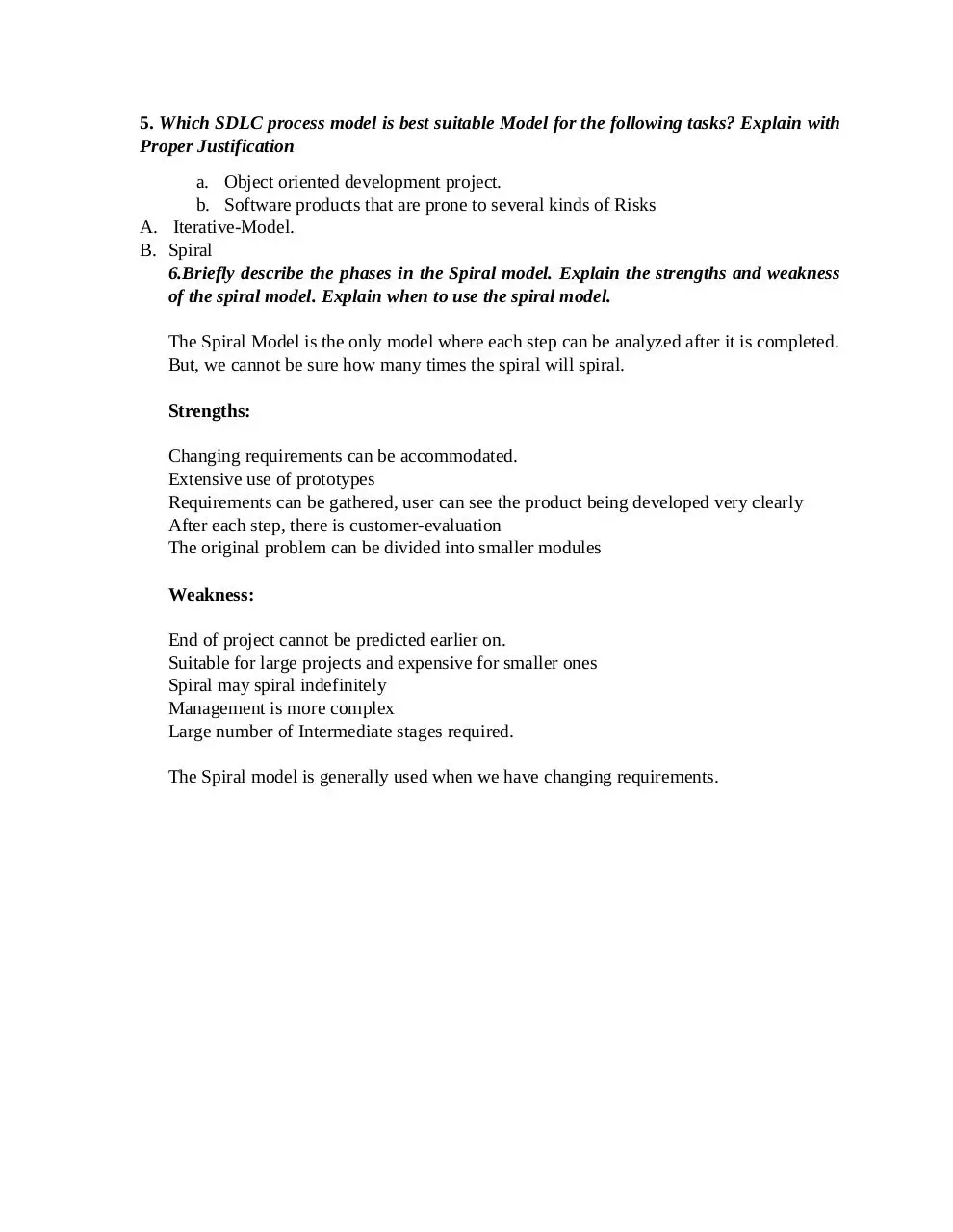
File preview
SE Assignment -1 Anish
1. What is the difference between cohesion and coupling? How can coupling and cohesion
lead to either good or poor software design? What are some examples that outline the
difference between the two, and their impact on overall code quality?
A.Cohesion is defined as the functional strength of a module. The functional strength of a
module should be high. A cohesive design class has a small focus set of responsibilities and
single-mindedly applies attributes and methods to implement those responsibilities.
Coupling is defined as the inter-dependency between modules. The coupling of a software
should be less. Within a design module, it is necessary for the design classes to collaborate with
one-another. BUT, Collaboration should be kept to an acceptable minimum. If a design model is
highly- coupled, that is, all design classes collaborate with all other design classes, the system is
difficult to implement, to test, and to maintain over time.
Cohesion
Coupling
Coupling is the indication
Cohesion is the indication of the
of the relationships between
relationship within module.
modules.
Coupling shows the relative
Cohesion shows the module’s relative
independence among the
functional strength.
modules.
Coupling is a degree to
Cohesion is a degree (quality) to which a
which a component /
component / module focuses on the
module is connected to the
single thing.
other modules.
While designing you should strive for
high cohesion i.e. a cohesive component/ While designing you should
module focus on a single task (i.e.,
strive for low coupling i.e.
single-mindedness) with little
dependency between
interaction with other modules of the
modules should be less.
system.
Cohesion is the kind of natural extension Making private fields,
of data hiding for example, class having private methods and non
all members visible with a package
public classes provides
having default visibility.
loose coupling.
Coupling is Inter -Module
Cohesion is Intra – Module Concept.
Concept.
2. Draw a Use case model for the given scenario
2
3.When you know programming, what is the need to learn software engineering concepts?
Which SDLC process model is best suitable Model for a Good GUI in terms of
Time, cost and other resources needed to design a S/W product. Justify your
answer along with the help of Strength and weakness of that Process model.
A. The development of an application is defined as programming. Software Engineering is defined as the
overall development of a high- quality software product. TO make a product efficiently and profitably, a
certain set of rules and standards needs to be followed. This can be learned via Software Engineering.
To perform any task, an industry-standard procedure is followed.
The best SDLC Model that is suitable to design a software product that has a good GUI, in terms of time,
costa and other resources is the Prototype- Process Model. It is the best model as it has a high- amount
of customer-involvement from the start and is developed in accordance with the customer’s
requirements and choices of the GUI.
Advantages:
It increases user-involvement in the product before complete development.
Better understanding of system before development
Defects can be detected earlier so that it’ll take less time and cost.
With Feedback from user, it shall be easier to develop and build the project in a better in a better way.
Some missing or confusing functionalities can be identified before-hand.
Disadvantages:
Due to insufficient requirements from the client at the initial stage, we are always dependent on them.
Methodology increases the complexity
It may increase management efforts to manage the project
Sometimes, there will be a confusion between prototype and the original design
Developer’s effort will be excess if the management does not efficiently monitor
Developers may try to re-use the existing prototype, but it is not possible.
4.What is Requirement gathering phase? What is SRS? Explain Functional and Non
Functional requirements along with examples. Collect the requirements of Air lines
reservation Systems.
A.Thephase in which the service-provider initiates a request to the client in order to know the
requirements and objectives of the high-quality software product to be made, via any means
such as e-mail, phone calls, video-conferencing etc. is known as the requirement gathering
phase.
SRS is software requirement specification. It is the documentation which provides a better
understanding of the software product to be made. It is a description of a software system to
be developed. It lays out the functional and non-functional requirements and may include a
set of use-cases that describe user-interactions that the software must provide.
Functional Requirements:
Those requirements that determine what the system will do. It defines the function of a
system and its components. It is described as a set of inputs, the behavior and the outputs
e.g.- Calculations, Technical Details, Data Manipulation and processing etc..
Non-Functional Requirements:
Those requirements that determine how the system will behave. It specifies criteria that
can be used to judge the operation of a system, rather than specific behaviors
E.g. – Reliability, Security, Portability, Inter-Operability etc.
Airline Reservation System:
Airline Reservations Systems contain airline schedules, fare tariffs, passenger reservations and ticket
records
The inventory of an airline is generally divided into service classes (e.g. First, Business or Economy class)
and up to 26 booking classes, for which different prices and booking conditions apply. Inventory data is
imported and maintained through a Schedule Distribution System over standardized interfaces. One of
the core functions of the inventory management is the inventory control. Inventory control steers how
many seats are available in the different booking classes, by opening and closing individual booking
classes for sale. In combination with the fares and booking conditions stored in the Fare Quote System
the price for each sold seat is determined.
This display contains flights, which are operated by the airline itself as well as code share flights which
are operated in co-operation with another airline. The availability of seats of other airlines is updated
through standard industry interfaces. Depending on the type of co-operation it supports access to the
last seat (Last Seat Availability) in real-time.
5. Which SDLC process model is best suitable Model for the following tasks? Explain with
Proper Justification
a. Object oriented development project.
b. Software products that are prone to several kinds of Risks
A. Iterative-Model.
B. Spiral
6.Briefly describe the phases in the Spiral model. Explain the strengths and weakness
of the spiral model. Explain when to use the spiral model.
The Spiral Model is the only model where each step can be analyzed after it is completed.
But, we cannot be sure how many times the spiral will spiral.
Strengths:
Changing requirements can be accommodated.
Extensive use of prototypes
Requirements can be gathered, user can see the product being developed very clearly
After each step, there is customer-evaluation
The original problem can be divided into smaller modules
Weakness:
End of project cannot be predicted earlier on.
Suitable for large projects and expensive for smaller ones
Spiral may spiral indefinitely
Management is more complex
Large number of Intermediate stages required.
The Spiral model is generally used when we have changing requirements.
Download Solutions-SE-1- Anish.PDF
Solutions-SE-1- Anish.PDF (PDF, 596.84 KB)
Download PDF
Share this file on social networks
Link to this page
Permanent link
Use the permanent link to the download page to share your document on Facebook, Twitter, LinkedIn, or directly with a contact by e-Mail, Messenger, Whatsapp, Line..
Short link
Use the short link to share your document on Twitter or by text message (SMS)
HTML Code
Copy the following HTML code to share your document on a Website or Blog
QR Code to this page
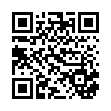
This file has been shared publicly by a user of PDF Archive.
Document ID: 0000340375.